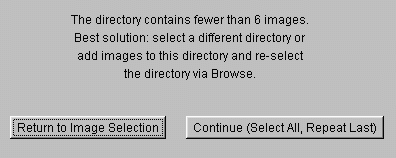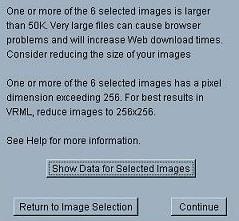Screen 2

This screen allows you to select which of the six images you would like to have displayed
on your cube or carousel. The images shown above are distributed with the software and are
located in the directory where the software was installed (C:/TriVista/ImageCube/example
by default). Initially, the first six images are selected. The selected images will have a
thick black border surrounding the image.
To change an image, click on a currently selected image to deselect it, followed by
clicking on the image you would like to use to select it. If you would like to change
several images, you can click the "Clear Selection" button in the lower right
hand corner, followed by clicking on the six images you would like to use.
If you would like to use images from a different directory, type in the name of the
directory you would like to use in the "Directory:" type-in area at the bottom
of the screen. If you do not know the name of the directory you would like to use, you can
click on the "Browse" button to select a directory. In this case, you will need
to double click on a file within a particular directory in order to select that directory.
If you choose a directory with many images, loading may take a few moments as all of
the images are processed. If you ever want to stop loading, simply click the
"Stop" button (next to the Browse button). If loading has been stopped, this
button will change to say "Resume" -- click it to continue loading where you
left off.
Note: The Image Cube files will be written in whatever directory you select
here. Therefore, do not select a directory on a device you cannot write to, such as your
CD-ROM drive. If you would like to use images from a CD-ROM, copy the images you would
like to use to your hard drive first.
If you select a directory which has fewer than six images, you will get the following
message.

At this point, you can click the "Return to Image Selection" and select a
different directory with at least six images in it, or you can copy enough images into the
current directory to bring the total up to six, then reread that directory. You can also
click Continue which will repeat the last image as many times as necessary to bring the
total up to six.
VRML players currently limit the resolution of images mapped onto objects. For example,
Cosmo Player limits the resolution of images mapped onto an object to 256x256. Therefore,
you will not gain any benefit by using images higher than that resolution on your image
cubes or carousels. Also, if you plan to publish your image cube on the Web, it is a good
idea to keep the image sizes small so that your image cube or carousel will not take too
long to download. Finally, we have occasionally seen Web browsers crash when trying to
view image cubes or carousels with high resolution (or large file size) images.
Therefore, if one or more of the images you select is greater than 50KB in size or has
a resolution greater than 256x256 a warning message similar to the following will
appear.

At this point you can click the "Show Data for Selected Images" button and
the file name for each selected image along with the resolution and file size will be
displayed. At this point you can either click "Return to Image Selection" and
choose different images, which may be smaller, or you can click "Continue" to
see if it works ok.
You might also consider using some image processing software to reduce the size of the
images. Several shareware products exist, such as Lview or Bitmap Shrinker, which allow
you to reduce the size of your images. Most scanners and digital cameras also come with
image processing software.
You will also get a warning message if the directory selected contains more than 100
images or if any of the files in the directory have a size greater than 100KB. The reason
for these warnings are because it takes a while to process a large number of files or big
files.


